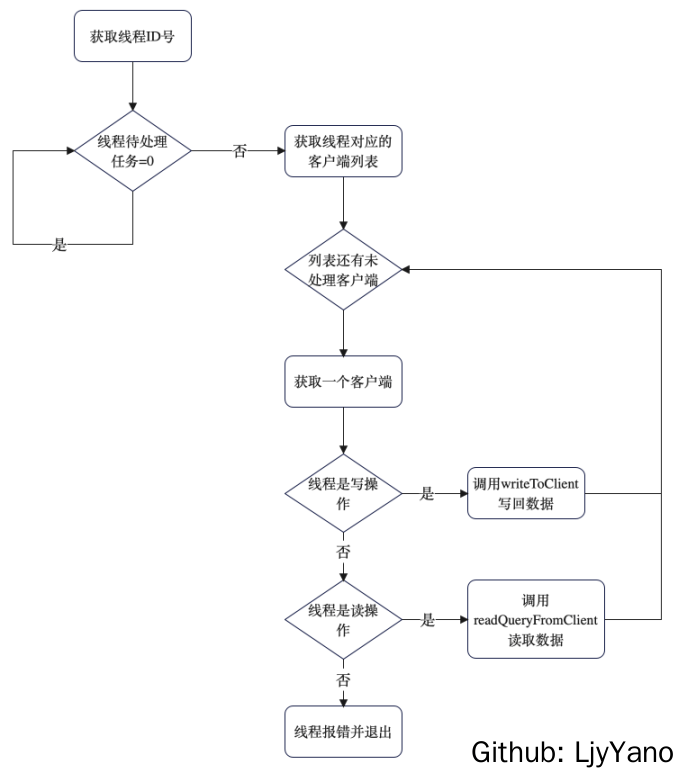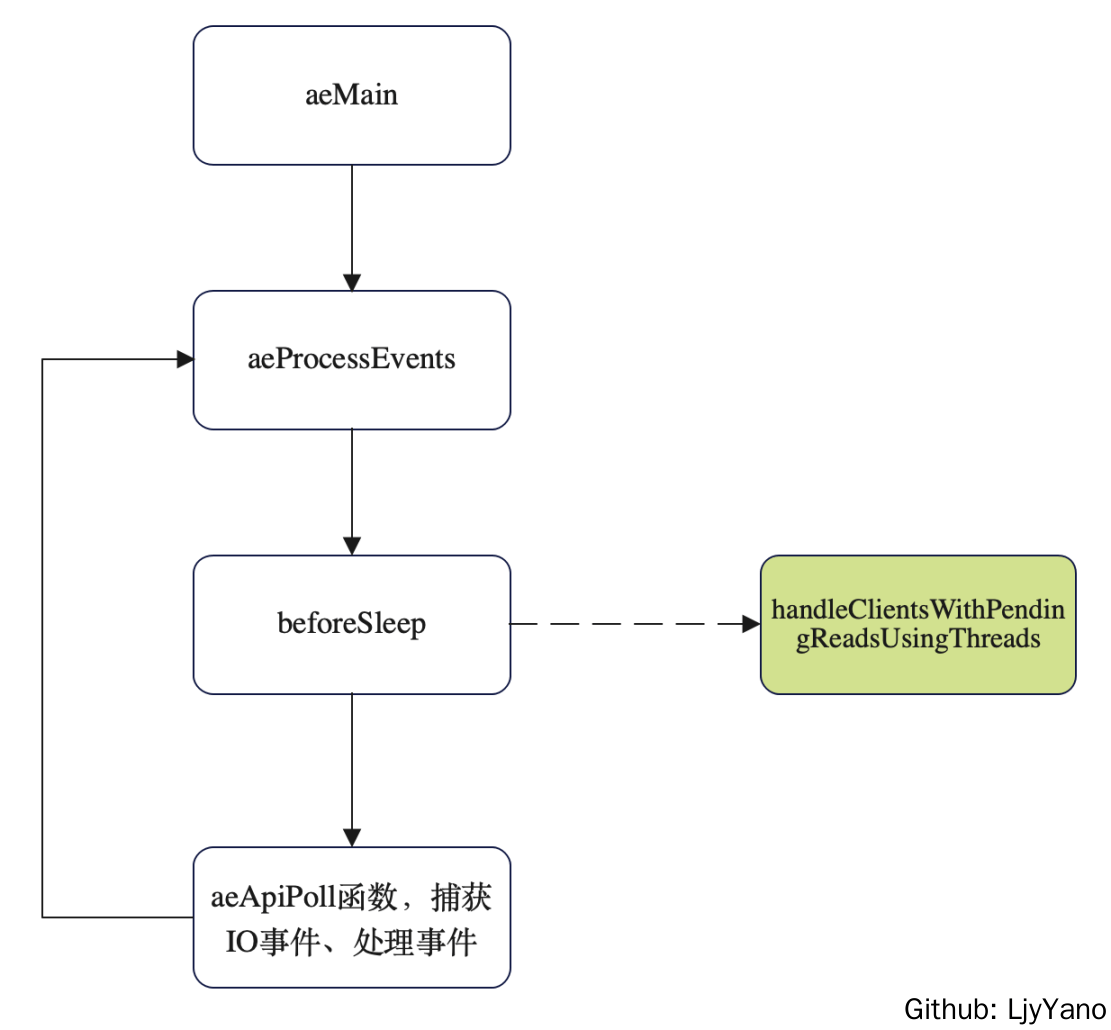Redis源码简洁剖析10—主 IO线程及 Redis 6.0 多 IO 线程原创
Redis 到底是不是单线程的程序?
Redis 只有在处理「客户端请求」时,是单线程的;整个 Redis server 不是单线程的,还有后台线程在辅助处理任务。
Redis 选择单线程处理请求,是因为 Redis 操作的是「内存」,加上设计了「高效」的数据结构,所以操作速度极快,利用 IO 多路复用机制,单线程依旧可以有非常高的性能。
Redis 不让主线程执行一些耗时操作,比如同步写、删除等,而是交给后台线程异步完成,从而避免了对主线程的阻塞。
在 2020 年 5 月推出的 Redis 6.0 版本中,还会使用多线程来处理 IO 任务,能够充分利用服务器的多核特性,使用多核运行多线程,让多线程帮助加速数据读取、命令解析和数据写回的速度,提升 Redis 的整体性能。
多 IO 线程的初始化
在 main 函数中,会调用 InitServerLast 函数,Redis 6.0 源码:
void InitServerLast() {
bioInit();
// 初始化 IO 线程
initThreadedIO();
set_jemalloc_bg_thread(server.jemalloc_bg_thread);
server.initial_memory_usage = zmalloc_used_memory();
}
在调用了 bioInit 函数后,又调用了 initThreadedIO 函数初始化多 IO 线程。initThreadedIO 函数在 networking.c 文件中。
void initThreadedIO(void) {
// IO 线程激活标志:设置为「未激活」
server.io_threads_active = 0;
// 只有 1 个 io 线程,直接返回,直接在主线程处理 IO
if (server.io_threads_num == 1) return;
if (server.io_threads_num > IO_THREADS_MAX_NUM) {
serverLog(LL_WARNING,"Fatal: too many I/O threads configured. "
"The maximum number is %d.", IO_THREADS_MAX_NUM);
exit(1);
}
/* Spawn and initialize the I/O threads. */
for (int i = 0; i < server.io_threads_num; i++) {
io_threads_list[i] = listCreate();
// Thread 0 是主线程
if (i == 0) continue;
/* Things we do only for the additional threads. */
pthread_t tid;
// 初始化 io_threads_mutex
pthread_mutex_init(&io_threads_mutex[i],NULL);
setIOPendingCount(i, 0);
pthread_mutex_lock(&io_threads_mutex[i]); /* Thread will be stopped. */
// pthread_create 创建 IO 线程,线程运行函数是 IOThreadMain
if (pthread_create(&tid,NULL,IOThreadMain,(void*)(long)i) != 0) {
serverLog(LL_WARNING,"Fatal: Can't initialize IO thread.");
exit(1);
}
// 初始化 io_threads 数组,设置值为线程标识
io_threads[i] = tid;
}
}
代码中首先判断 io_threads_num:
- io_threads_num = 1,表示直接在主线程处理,直接返回
- io_threads_num > IO_THREADS_MAX_NUM,表示 IO 线程数量>宏定义的值(默认值 128),直接退出程序
initThreadedIO 函数就会给以下四个数组进行初始化操作:
- io_threads_list 数组:保存了每个 IO 线程要处理的客户端,将数组每个元素初始化为一个 List 类型的列表
- io_threads_pending 数组:保存等待每个 IO 线程处理的客户端个数
- io_threads_mutex 数组:保存线程互斥锁
- io_threads 数组:保存每个 IO 线程的描述符
这四个数组的定义都在 networking.c 文件中:
pthread_t io_threads[IO_THREADS_MAX_NUM]; //记录线程描述符的数组
pthread_mutex_t io_threads_mutex[IO_THREADS_MAX_NUM]; //记录线程互斥锁的数组
_Atomic unsigned long io_threads_pending[IO_THREADS_MAX_NUM]; //记录线程待处理的客户端个数
list *io_threads_list[IO_THREADS_MAX_NUM]; //记录线程对应处理的客户端
initThreadedIO 函数在 for 循环中,调用 pthread_create 函数创建线程。pthread_create 详细语法见:pthread_create(3) — Linux manual page。
创建的线程要运行的函数是 IOThreadMain,*arg 参数就是当前创建线程的编号(从 1 开始,0 是主 IO 线程)。
/* Spawn and initialize the I/O threads. */
for (int i = 0; i < server.io_threads_num; i++) {
io_threads_list[i] = listCreate();
// Thread 0 是主线程
if (i == 0) continue;
/* Things we do only for the additional threads. */
pthread_t tid;
// 初始化 io_threads_mutex
pthread_mutex_init(&io_threads_mutex[i],NULL);
setIOPendingCount(i, 0);
pthread_mutex_lock(&io_threads_mutex[i]);
// pthread_create 创建 IO 线程,线程运行函数是 IOThreadMain
if (pthread_create(&tid,NULL,IOThreadMain,(void*)(long)i) != 0) {
serverLog(LL_WARNING,"Fatal: Can't initialize IO thread.");
exit(1);
}
// 初始化 io_threads 数组,设置值为线程标识
io_threads[i] = tid;
}
IO 线程运行函数 IOThreadMain
主要逻辑是一个 while(1) 的循环,会把 io_threads_list 在这个线程对应的元素取出来,判断并处理。
void *IOThreadMain(void *myid) {
……
while(1) {
/* Wait for start */
for (int j = 0; j < 1000000; j++) {
if (getIOPendingCount(id) != 0) break;
}
……
// 获取 IO 线程要处理的客户端列表
listRewind(io_threads_list[id],&li);
while((ln = listNext(&li))) {
// 从客户端列表中获取一个客户端
client *c = listNodeValue(ln);
// 线程是「写操作」,调用 writeToClient 将数据写回客户端
if (io_threads_op == IO_THREADS_OP_WRITE) {
writeToClient(c,0);
// 如果是『读操作』,调用 readQueryFromClient 从客户端读数据
} else if (io_threads_op == IO_THREADS_OP_READ) {
readQueryFromClient(c->conn);
}
……
}
// 处理完所有客户端,清空该线程的客户端列表
listEmpty(io_threads_list[id]);
// 将该线程的待处理任务数量设为 0
setIOPendingCount(id, 0);
}
}
注:上面代码中 io_threads_op 变量是在 handleClientsWithPendingWritesUsingThreads 函数和 handleClientsWithPendingReadsUsingThreads 函数中设置的。
问题:IO 线程要处理的客户端是如何添加到 io_threads_list 数组中的呢?
是在 redisServer 全局变量里,有两个 List 类型的成员变量:
- clients_pending_write:待写回数据的客户端
- clients_pending_read:待读取数据的客户端
struct redisServer {
...
// 待写回数据的客户端
list *clients_pending_write;
// 待读取数据的客户端
list *clients_pending_read;
...
}
Redis server 在接收到客户端请求、返回给客户端数据的过程中,会根据一定条件,推迟客户端的读写操作,并分别把待读写的客户端保存到这两个列表中。之后 Redis server 每次进入事件循环前,都会把列表中的客户端添加到 io_threads_list 数组中,交给 IO 线程处理。
如何推迟客户端「读」操作?
处理可读事件的回调函数是 readQueryFromClient。
void readQueryFromClient(connection *conn) {
// 从 connection 结构中获取客户端
client *c = connGetPrivateData(conn);
……
// 是否推迟从客户端读取数据(使用多线程 IO 时)
if (postponeClientRead(c)) return;
……
}
主要看下 postponeClientRead 函数。
int postponeClientRead(client *c) {
if (server.io_threads_active &&
server.io_threads_do_reads &&
!ProcessingEventsWhileBlocked &&
!(c->flags & (CLIENT_MASTER|CLIENT_SLAVE|CLIENT_PENDING_READ|CLIENT_BLOCKED)))
{
// 客户端 flag 添加 CLIENT_PENDING_READ 标记,推迟客户端的读操作
c->flags |= CLIENT_PENDING_READ;
// 将客户端添加到 server 的 clients_pending_read 列表中
listAddNodeHead(server.clients_pending_read,c);
return 1;
} else {
return 0;
}
}
if 的判断条件:是否可以推迟当前客户端的读操作;if 块里的执行逻辑:将客户端添加到 clients_pending_read 列表中。下面主要看下判断条件:
- server.io_threads_active = 1:多 IO 线程已激活。
- server.io_threads_do_reads = 1:多 IO 线程可用于处理延迟执行的客户端读操作,是在 Redis 配置文件 redis.conf 中,通过配置项 。io-threads-do-reads 设置的,默认值为 no。
- ProcessingEventsWhileBlocked = 0:ProcessingEventsWhileBlocked 函数没有在执行,当 Redis 在读取 RDB 文件或 AOF 文件时,会调用这个函数,用来处理事件驱动框架捕获到的事件,避免因读取 RDB 或 AOF 文件造成 Redis 阻塞。
- 客户端现有标识不能有 CLIENT_MASTER、CLIENT_SLAVE 和 CLIENT_PENDING_READ
- CLIENT_MASTER:客户端用于主从复制
- CLIENT_SLAVE:客户端用于主从复制
- CLIENT_PENDING_READ:客户端本来就被设置为推迟读操作
如何推迟客户端「写」操作?
Redis 在执行了客户端命令,要给客户端返回结果时,会调用 addReply 函数将待返回的结果写入输出缓冲区。addReply 函数开始就会调用 prepareClientToWrite 函数。
/* -----------------------------------------------------------------------------
* Higher level functions to queue data on the client output buffer.
* The following functions are the ones that commands implementations will call.
* -------------------------------------------------------------------------- */
/* Add the object 'obj' string representation to the client output buffer. */
void addReply(client *c, robj *obj) {
if (prepareClientToWrite(c) != C_OK) return;
……
}
prepareClientToWrite 函数的注释如下:
/* This function is called every time we are going to transmit new data
* to the client. The behavior is the following:
*
* If the client should receive new data (normal clients will) the function
* returns C_OK, and make sure to install the write handler in our event
* loop so that when the socket is writable new data gets written.
*
* If the client should not receive new data, because it is a fake client
* (used to load AOF in memory), a master or because the setup of the write
* handler failed, the function returns C_ERR.
*
* The function may return C_OK without actually installing the write
* event handler in the following cases:
*
* 1) The event handler should already be installed since the output buffer
* already contains something.
* 2) The client is a slave but not yet online, so we want to just accumulate
* writes in the buffer but not actually sending them yet.
*
* Typically gets called every time a reply is built, before adding more
* data to the clients output buffers. If the function returns C_ERR no
* data should be appended to the output buffers. */
int prepareClientToWrite(client *c) {
……
// 当前客户端没有待写回数据 && flag 不包含 CLIENT_PENDING_READ
if (!clientHasPendingReplies(c) && !(c->flags & CLIENT_PENDING_READ))
clientInstallWriteHandler(c);
return C_OK;
}
clientInstallWriteHandler 如下,if 判断条件就不赘述了。
void clientInstallWriteHandler(client *c) {
if (!(c->flags & CLIENT_PENDING_WRITE) &&
(c->replstate == REPL_STATE_NONE ||
(c->replstate == SLAVE_STATE_ONLINE && !c->repl_put_online_on_ack)))
{
// 将客户端的标识设置为 CLIENT_PENDING_WRITE(待写回)
c->flags |= CLIENT_PENDING_WRITE;
// 将 client 加入 server 的 clients_pending_write 列表
listAddNodeHead(server.clients_pending_write,c);
}
}
上面介绍如如何推迟客户端的读操作、写操作,那 Redis 是如何将推迟读写操作的客户端,分配给多 IO 线程执行的呢?是通过:
- handleClientsWithPendingReadsUsingThreads 函数:将 clients_pending_read 列表中的客户端分配给 IO 线程
- handleClientsWithPendingWritesUsingThreads 函数:将 clients_pending_write 列表中的客户端分配给 IO 线程
如何把待「读」客户端分配给 IO 线程执行?
beforeSleep 函数中调用了 handleClientsWithPendingReadsUsingThreads 函数:
/* We should handle pending reads clients ASAP after event loop. */
handleClientsWithPendingReadsUsingThreads();
handleClientsWithPendingReadsUsingThreads 函数如下,逻辑都在注释中:
/* When threaded I/O is also enabled for the reading + parsing side, the
* readable handler will just put normal clients into a queue of clients to
* process (instead of serving them synchronously). This function runs
* the queue using the I/O threads, and process them in order to accumulate
* the reads in the buffers, and also parse the first command available
* rendering it in the client structures. */
int handleClientsWithPendingReadsUsingThreads(void) {
// 判断 io_threads_active 是否被激活,io_threads_do_reads 是否可以用 IO 线程处理待读客户端
if (!server.io_threads_active || !server.io_threads_do_reads) return 0;
// 判断 clients_pending_read 长度
int processed = listLength(server.clients_pending_read);
if (processed == 0) return 0;
/* Distribute the clients across N different lists. */
listIter li;
listNode *ln;
// 获取 clients_pending_read 的客户端列表
listRewind(server.clients_pending_read,&li);
// 轮询方式,将客户端分配给 IO 线程
int item_id = 0;
while((ln = listNext(&li))) {
client *c = listNodeValue(ln);
int target_id = item_id % server.io_threads_num;
listAddNodeTail(io_threads_list[target_id],c);
item_id++;
}
// 将 IO 线程的操作标识设置为「读操作」
io_threads_op = IO_THREADS_OP_READ;
for (int j = 1; j < server.io_threads_num; j++) {
// 每个线程等待处理的客户端数量 → io_threads_pending 数组
int count = listLength(io_threads_list[j]);
setIOPendingCount(j, count);
}
// 处理 0 号线程(主线程)的待读客户端
listRewind(io_threads_list[0],&li);
while((ln = listNext(&li))) {
client *c = listNodeValue(ln);
readQueryFromClient(c->conn);
}
// 清空 0 号列表
listEmpty(io_threads_list[0]);
// 循环,等待其他所有 IO 线程的待读客户端都处理完
while(1) {
unsigned long pending = 0;
for (int j = 1; j < server.io_threads_num; j++)
pending += getIOPendingCount(j);
if (pending == 0) break;
}
/* Run the list of clients again to process the new buffers. */
// 取出 clients_pending_read 列表
while(listLength(server.clients_pending_read)) {
ln = listFirst(server.clients_pending_read);
client *c = listNodeValue(ln);
// 判断客户端标识符是否有 CLIENT_PENDING_READ,有则表示被 IO 线程解析过
c->flags &= ~CLIENT_PENDING_READ;
// 将客户端从 clients_pending_read 列表中删掉
listDelNode(server.clients_pending_read,ln);
serverAssert(!(c->flags & CLIENT_BLOCKED));
if (processPendingCommandsAndResetClient(c) == C_ERR) {
/* If the client is no longer valid, we avoid
* processing the client later. So we just go
* to the next. */
continue;
}
// 解析并执行客户端的所有命令
processInputBuffer(c);
/* We may have pending replies if a thread readQueryFromClient() produced
* replies and did not install a write handler (it can't).
*/
if (!(c->flags & CLIENT_PENDING_WRITE) && clientHasPendingReplies(c))
clientInstallWriteHandler(c);
}
/* Update processed count on server */
server.stat_io_reads_processed += processed;
return processed;
}
如何把待「写」客户端分配给 IO 线程执行?
待写客户端的分配处理是由 handleClientsWithPendingWritesUsingThreads 函数完成的,该函数也是在 beforeSleep 函数中调用的。逻辑和 handleClientsWithPendingReadsUsingThreads 函数很像。
int handleClientsWithPendingWritesUsingThreads(void) {
// 判断 clients_pending_write 列表的数量
int processed = listLength(server.clients_pending_write);
if (processed == 0) return 0;
// 只有主 IO 线程 || 不使用 IO 线程
if (server.io_threads_num == 1 || stopThreadedIOIfNeeded()) {
return handleClientsWithPendingWrites();
}
/* Start threads if needed. */
if (!server.io_threads_active) startThreadedIO();
/* Distribute the clients across N different lists. */
listIter li;
listNode *ln;
listRewind(server.clients_pending_write,&li);
int item_id = 0;
// 把待写客户端,按照轮询方式分配给 IO 线程
while((ln = listNext(&li))) {
client *c = listNodeValue(ln);
c->flags &= ~CLIENT_PENDING_WRITE;
if (c->flags & CLIENT_CLOSE_ASAP) {
listDelNode(server.clients_pending_write, ln);
continue;
}
int target_id = item_id % server.io_threads_num;
listAddNodeTail(io_threads_list[target_id],c);
item_id++;
}
// 将 IO 线程的操作标识设置为「写操作」
io_threads_op = IO_THREADS_OP_WRITE;
for (int j = 1; j < server.io_threads_num; j++) {
// 每个线程等待处理的客户端数量 → io_threads_pending 数组
int count = listLength(io_threads_list[j]);
setIOPendingCount(j, count);
}
/* Also use the main thread to process a slice of clients. */
listRewind(io_threads_list[0],&li);
while((ln = listNext(&li))) {
client *c = listNodeValue(ln);
writeToClient(c,0);
}
listEmpty(io_threads_list[0]);
// 循环,等待其他所有 IO 线程的待写客户端都处理完
while(1) {
unsigned long pending = 0;
for (int j = 1; j < server.io_threads_num; j++)
pending += getIOPendingCount(j);
if (pending == 0) break;
}
/* Run the list of clients again to install the write handler where
* needed. */
listRewind(server.clients_pending_write,&li);
while((ln = listNext(&li))) {
client *c = listNodeValue(ln);
// 再次检查是否有待写客户端
if (clientHasPendingReplies(c) &&
connSetWriteHandler(c->conn, sendReplyToClient) == AE_ERR)
{
freeClientAsync(c);
}
}
listEmpty(server.clients_pending_write);
/* Update processed count on server */
server.stat_io_writes_processed += processed;
return processed;
}
需要注意的是,stopThreadedIOIfNeeded 函数中会判断待写入的客户端数量如果 < IO 线程数 * 2,则也会直接返回,直接使用主 IO 线程处理待写客户端。这是因为待写客户端不多时,使用多线程效率反而会下降。
int stopThreadedIOIfNeeded(void) {
int pending = listLength(server.clients_pending_write);
/* Return ASAP if IO threads are disabled (single threaded mode). */
if (server.io_threads_num == 1) return 1;
if (pending < (server.io_threads_num*2)) {
if (server.io_threads_active) stopThreadedIO();
return 1;
} else {
return 0;
}
}
总结
Redis 6.0 实现的多 IO 线程机制,主要是使用多个 IO 线程,并发处理客户端读取数据、解析命令、写回数据,充分利用服务器的多核特性,提高 IO 效率。
Redis server 会根据 readQueryFromClient 函数调用 postponeClientRead 函数决定是否要推迟客户端操作;会根据 addReply 函数中的 prepareClientToWrite 函数,决定是否推迟客户端的写操作。待读客户端加入到 clients_pending_read 列表,待写客户端加入 clients_pending_write 列表。
IO 线程创建之后,会一直检测 io_threads_list 列表,如果有待读写的客户端,IO 线程就会调用 readQueryFromClient 或 writeToClient 函数进行处理。
但是多 IO 线程并不会执行命令,执行命令仍然在主 IO 线程。





